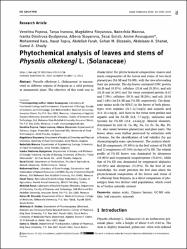| dc.contributor.author | Popova, Venelina | |
| dc.contributor.author | Ivanova, Tanya | |
| dc.contributor.author | Stoyanova, Magdalena | |
| dc.contributor.author | Mazova, Nadezhda | |
| dc.contributor.author | Dimitrova-Dyulgerova, Ivanka | |
| dc.contributor.author | Stoyanova, Albena | |
| dc.contributor.author | Ercisli, Sezai | |
| dc.contributor.author | Topçu, Hayat | |
| dc.date.accessioned | 2023-05-06T17:23:41Z | |
| dc.date.available | 2023-05-06T17:23:41Z | |
| dc.date.issued | 2022 | |
| dc.identifier.issn | 2391-5420 | |
| dc.identifier.uri | https://doi.org/10.1515/chem-2022-0226 | |
| dc.identifier.uri | https://hdl.handle.net/20.500.11776/12248 | |
| dc.description.abstract | Physalis alkekengi L. (Solanaceae) is encountered in different regions of Bulgaria as a wild growing or ornamental plant. The objective of this work was to characterize the phytochemical composition (macro and micro components) of the leaves and stems of two local phenotypes (PA-SB and PA-NB), with the view of revealing their use potential. The dry leaves contained (DW) protein (16.25 and 19.27%), cellulose (25.16 and 25.31%), and ash (18.28 and 16.16%) and the stems contained protein (6.83 and 7.35%), cellulose (39.34 and 38.25%), and ash (15.01 and 7.48%) for PA-SB and PA-NB, respectively. The dominant amino acids (by HPLC) in the leaves of both phenotypes were arginine (21.3-22.3 mg/g) and aspartic acid (8.8-18.4 mg/g), and those in the stems were proline and aspartic acid for PA-SB (8.8, 7.7 mg/g); isoleucine and tyrosine for PA-NB (12.8, 6.6 mg/g). Mineral elements, determined by AAS (K, Ca, Mg, Na, Cu, Fe, Zn, Mn, Pb, Cr), also varied between phenotypes and plant parts. The leaves alone were further processed by extraction with n-hexane, for the identification of leaf volatiles (by gas chromatography-mass spectrometry). The analysis identified 28 components (97.99%) in the leaf extract of PA-SB and 32 components (97.50%) in that of PA-NB. The volatile profile of PA-SB leaves was dominated by diterpenes (49.96%) and oxygenated sesquiterpenes (35.61%), while that of PA-NB was dominated by oxygenated aliphatics (40.01%) and diterpenes (35.19%). To the best of our knowledge, the study provides the first data about the phytochemical composition of the leaves and stems of P. alkekengi from Bulgaria, in a direct comparison of phenotypes from two distinct wild populations, which could be of further scientific interest. | en_US |
| dc.description.sponsorship | AlMaarefa University, Riyadh, Saudi Arabia; [2021-29] | en_US |
| dc.description.sponsorship | The authors deeply acknowledge the Researchers Supporting Program (TUMA Project-2021-29), AlMaarefa University, Riyadh, Saudi Arabia, for supporting steps of this work. | en_US |
| dc.language.iso | eng | en_US |
| dc.publisher | De Gruyter Poland Sp Z O O | en_US |
| dc.identifier.doi | 10.1515/chem-2022-0226 | |
| dc.rights | info:eu-repo/semantics/openAccess | en_US |
| dc.subject | amino acids | en_US |
| dc.subject | Chinese lantern | en_US |
| dc.subject | GC-MS volatiles | en_US |
| dc.subject | leaf concrete | en_US |
| dc.subject | minerals | en_US |
| dc.subject | Antimicrobial Activity | en_US |
| dc.subject | Chemical-Constituents | en_US |
| dc.subject | Biological-Activities | en_US |
| dc.subject | L. | en_US |
| dc.subject | Antioxidant | en_US |
| dc.subject | Profiles | en_US |
| dc.subject | Plants | en_US |
| dc.title | Phytochemical analysis of leaves and stems of Physalis alkekengi L. (Solanaceae) | en_US |
| dc.type | article | en_US |
| dc.relation.ispartof | Open Chemistry | en_US |
| dc.department | Fakülteler, Ziraat Fakültesi, Tarımsal Biyoteknoloji Bölümü | en_US |
| dc.authorid | Shahat, Abdelaaty Abdelaziz/0000-0003-0456-3196 | |
| dc.authorid | Assouguem, Dr. Amine/0000-0002-4013-3516 | |
| dc.identifier.volume | 20 | en_US |
| dc.identifier.issue | 1 | en_US |
| dc.identifier.startpage | 1292 | en_US |
| dc.identifier.endpage | 1303 | en_US |
| dc.institutionauthor | Topçu, Hayat | |
| dc.relation.publicationcategory | Makale - Uluslararası Hakemli Dergi - Kurum Öğretim Elemanı | en_US |
| dc.authorwosid | Shahat, Abdelaaty Abdelaziz/C-4100-2011 | |
| dc.authorwosid | Abdelmenam, Jehan/HJA-5589-2022 | |
| dc.authorwosid | Assouguem, Dr. Amine/HQY-5761-2023 | |
| dc.identifier.wos | WOS:000889329900001 | en_US |
| dc.identifier.scopus | 2-s2.0-85143531020 | en_US |



















